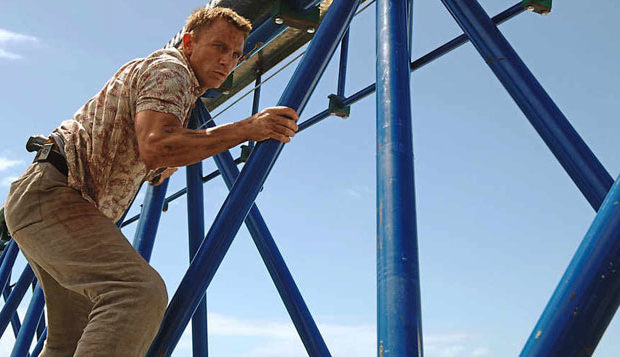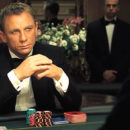INNER 007 -- Before I was a James Bond fan, I was a Tarzan fan. I read all the books and thrilled to his ability to navigate the outdoor world, no matter what was thrown at him. Rock wall? He'd find a way. Cover 10 miles in the jungle before the Bull Mangani attacked Jane and the rest of the safari? No problem.
So you can imagine how I felt the first time I saw the YouTube video entititled "The Workout The World Forgot." In it, a fellow named Erwan Le Corre lifts logs and carries them down rivers, climbs trees, clambers over seemingly impassible rock walls, scrambles down mountainsides covered in scree, swims down pristine rivers, and grapples with opponents that challenge him. It's intoxicating to watch.
And what's amazing is that he does it all in nothing but a pair of shorts. He's not even wearing any shoes.
It took me back to the now-famous chase scene at the beginning of Casino Royale in 2006, when Bond chased the bomb-maker Mollaka (played by parkour luminary Sébastien Foucan) through a construction site and scrambled to keep up while Mollaka lept, climbed, and vaulted his way through the scene. It was easily my favorite ever Bond movie chase.
Le Corre is the founder of MovNat, a fitness methodology that strives to free human beings from the artificial world we've created and return us to a time when our bodies were strong, supple, capable, and most importantly, useful. MovNat is about throwing away the gym mentality of reps, programming, "no pain - no gain," and isolation from the natural world. Instead, the methods of MovNat come from what Le Corre calls the basic movement skills of the human body in the natural environment: the locomotive skills of walking, running, jumping, balancing, crawling, climbing, and swimming; and also the manipulative skills of lifting, carrying, throwing and catching.
This sounds pretty basic. And frankly, it should be. Had we grown up in an environment like our pre-modern civilization ancestors, we'd be doing all these things instinctively because we'd have grown up doing them just for survival. But here's the rub: because we haven't grown up doing these things regularly, we've forgotten how and have to relearn. We also have to retrain our bodies to do these things because modern conveniences like chairs, cars, unnatural workout regimens, and even things like shoes and beds have warped our bodies out of proper alignment and strength.
This hasn't just made us stiff and inflexible in the ways that matter, it's made us sick, weak, and more susceptible to injury. Not only are our bodies capable of the feats the Le Corre shows in the many MovNat videos, they actually expect us to do them regularly. The specialization of the world of athletics is actually hurting us more than it's helping. No where is that more clear today than in the world of youth athletics. Our kids, who thirty years ago were outside running, playing, exploring woods, wrestling, and swimming are now suffering from injuries that used to be only seen at the highest ranks of athletics: ACL injuries, rotator cuff problems, worn joints, back problems, and more. Being pushed into athletic specialization at a young age has made our kids more fragile.
And these are the lucky kids - the ones who actually get exercise.
MovNat was greatly influenced by the works of Georges Hébert. Hébert was a French Navy officer who pioneered a physical philosophy called La Methode Naturelle or the Natural Method. Prior to World War I, Hébert witnessed a volcanic eruption on the island of Martinique, where he was aghast at the number of people who had lost the ability, through disuse, of people to save themselves or others from the disaster. They simply couldn't do things like lift another person and carry them, or climb rubble, or even have the instinct to try these things. He dedicated himself to a study of how primitive people moved and exercised, and described the overall goal of his method as making people not only strong, but altruistic. His his personal motto was, "Être fort pour être utile" ("Being strong to be useful").
MovNat carries on that goal. It starts by introducing people to many of these movements at a very easy and sometimes almost humiliatingly basic level and then slowly increasing the difficulty of the movement. For instance, jumping and landing is first practiced by jumping three or four feet straight in front of you and landing. It seems simple, until you learn how to land properly and absorb the impact with your knees and a slight elastic squat. The next step might be a precision jump and land - from one mat to another, for example. That might be followed by jumping onto a two-by-four without falling off, then from one log to another to work landing on unbalanced surfaces.
Another example might be crawling. You learn the basic foot hand crawl - and learn the proper form for it (keep your back parallel to the ground, not sticking your butt up in the air, and moving your left foot and right hand in tandem, followed by the right foot and left hand). Then you move to a narrower surface to do this, followed by a trip back to the two-by-four, and then the log. Or down some stairs.
Everything in MovNat is done in progressions, to re-teach our bodies how to move properly and effectively. And I speak from experience when I say that it works not only the body, but also the way we see the world. You no longer just see a wall in front of you, for example, but rather you start looking for ways to climb the wall - where handholds might be, how much of a runup you might need to get to them, how you might use that trash can or railing to boost yourself slightly, and more. It changes the way you look at the world.
Think of Bond and his pursuit of Mollaka in Casino Royale again. He may not have Mollaka's parkour skills, but he figures out ways to get where he needs to go to stay on the bomb-maker's tail. That's the essence of MovNat - knowing how to use your body to be useful and get the job done.
MovNat seminars are now held all over the world. Everything from half-day seminars in your home town to five-day retreats to places like West Virginia, Thailand, Brazil, New Mexico, and more are taking place all over the world. And there are MovNat certfied trainers throughout the world who can teach you these fundamental movement techiques and help you improve your body to be useful to yourself and others.
So what can you expect when you take a MovNat training seminar?
First, it's important to go in with the right attitude. So much of the training will seem to be rudimentary and almost insulting at times. And frankly, depending on your past exercise and athletic history, some of it may be. But be open-minded. You're going to learn about things you've been doing wrong and how those things may have led to injuries or other limitations in your movement capabilities. Too much sitting, for example, may make it difficult for you to attain a deep squat, which is a perfectly natural way for humans to rest. You'll learn how all the warnings to never squat with your knees in front of your toes arei nothing more than trying to help broken people (from too much sitting) avoid breaking themselves further - but a supple MovNat-trained person will have no problem attaining a deep, restful squat. You'll learn how to land when you jump. You'll learn proper balance techniques and how to lift a log to your shoulder that, frankly, you'll never believe you could.
Second, listen to everything that is told to you. Yes, it may all seem easy, as we said before. But all these skills you'll learn are going to build on themselves and each other. Missing a step in between is going to make the transitions to more challenging movements harder for you. Don't miss a step.
Third, get ready to be taken out of your comfort zone. Most MovNat training sessions take place outdoors. You may find yourself walking down a stream holding a log, such as Le Corre does in the "Workout the World Forgot" video. Or crab-walking down a steep ravine. Or doing a hand-foot crawl across a log over a stream. Or deadlifting and playing catch with rocks. Or even belly crawling through the leaves and dirt of a local park. You don't know what you'll encounter because that's the way life really is. Being MovNat-trained means getting yourself ready for anything.
But I promise you this: when you're finished, you'll never take movement for granted again. You're going to see and experience the world in a different way, knowing that you're on the path to "being strong to be useful." You're going to be more in touch with your own body, knowing what movements in craves and most importantly a ton of ways to feed that craving.
It's at this point that MovNat becomes less of a workout and more of a practice - like Yoga or a martial art.
If you're like me, MovNat will lead to a drive for bigger challenges like obstacle course races such as Tough Mudder or Warrior Dash. It may lead you to learn parkour or take on competitions like American Ninja Warrior. Or it may just be a way for you to keep loose, enjoy the great outdoors, and keep up with your kids' playtime.
Whatever your physical endeavors, MovNat can improve them by making your movements more natural and healthful. Check out the website at http://www.movnat.com for more.
Also, the book Sandy was referring to as "Burn" is in fact Spark: The Revolutionary New Science of Exercise and the Brain by John Ratey. Check it out!











Top 5 Rejected James Bond Theme Songs
Top 5 Rejected James Bond Theme Songs
The "No Time To Die" Review